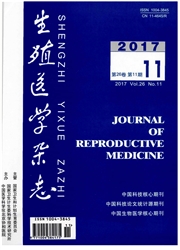

 中文摘要:
中文摘要:
目的分析在促性腺激素释放激素拮抗剂(GnRH-ant)方案控制性超促排卵(COH)过程中出现血清雌二醇(E2)下降时对体外受精-胚胎移植(IVF-ET)妊娠结局的影响,并探讨其临床处理对策。方法回顾性分析多囊卵巢综合征(PCOS)患者接受GnRH-ant方案中出现E2下降的30例(E2下降组)及E2持续上升的30例(对照组)的临床资料,并将E2下降组分为药物调整后E2下降组(n=18)和自发性E2下降组(n=12),比较3组患者的IVF妊娠结局。结果 (1)与对照组相比,药物调整后E2下降组或自发性E2下降组患者年龄、不孕年限、基础性激素水平、正常受精率、2PN卵裂率、优胚率均无统计学差异(P〉0.05);(2)药物调整后E2下降组促性腺激素(Gn)用量为2 015.3±727.5U,显著高于对照组(1 468.5±298.5U)及自发性E2下降组(1 673.3±637.5U)(P均〈0.05);药物调整后E2下降组和自发性E2下降组患者Gn刺激天数分别为(13.54±4.14)d和(12.75±3.84)d,较对照组Gn刺激天数[(10.08±1.26)d]显著增加(P〈0.05);药物调整后E2下降组及自发性E2下降组HCG日E2值分别为7 421.29±3 151.80pmol/L和9 469.52±3 401.36pmol/L,显著低于对照组(13 590.56±3 223.36pmol/L)(P〈0.01);药物调整后E2下降组患者HCG日孕酮(P)值为2.28±1.11nmol/L,显著低于对照组(3.56±1.30nmol/L)及自发性E2下降组(3.56±1.56nmol/L)(P〈0.05);自发性E2下降组临床妊娠率为33.33%,显著低于对照组(46.15%)及药物调整后E2下降组(43.84%)(P〈0.05)。结论在GnRH-ant方案中,药物调整导致E2下降,但通过及时添加HMG,不影响IVF结局;而在早卵泡期即出现的自发性E2下降,则预示不良结局。因此,密切监测卵泡大小及激素变化水平,在添加GnRH-ant时慎重调整Gn用量,是避免E2下降给IVF-ET带来影响的有效对策。
 英文摘要:
英文摘要:
Objective: To analyze the effect of decreasing estradiol levels in controlled ovarian hyperstimulation (COH) with GnRH antagonist (GnRH-ant) protocol on the outcome of IVF-ET in PCOS patients and explore the clinical treatment measures. Methods: The clinical data of 60 patients with PCOS were retrospectively analyzed. Among them,30 patients had decrease of E2 levels (study group),and another 30 patients had increase of E2 levels (control group) in GnRH antagonist protocol. The patients of study group were subdivided into two groups: the E2 levels were decreased after adjustment of drugs in 18 patients (drug adjustment group),and E2levels were decreased spontaneously in 12 patients (spontaneous group). The IVF outcomes of patients were compared among the three groups. Rustles: There was no statistical difference in age,infertility duration,basal hormone levels,fertility rate,2PN cleavage rate, high quality embryo rate among the three groups (P〉0.05). The dose of gonadotropin (Gn) used in drug adjustment group [(2 015.3±727.5) U] was significantly more than that in the spontaneous group [(1 673.3±637.5) U] and control group [(1 468.5±298.5)U] (P〈0.05). The days of Gn stimulation in the drug adjustment group [(13.54 ± 4.14)days] or in the spontaneous group [(12.75±3.84)days] were significantly more than those in the control group [(10.08±1.26)days] (P〈0.05). The E2 levels on HCG day in the drug adjustment group [(7 421.29±3 151.80) pmol/L] and the spontaneous group [(9 469.52±3 401.36)pmol/L] were significantly lower than those in the control group [(13 590. 56±3 223.36 pmol/L)] (P〈0.05). The progesterone levels on HCG day in the drug adjustment group [(2.28±1. 11)nmol/L] were significantly lower than that in the control group [(3.56± 1.30) nmol/L-] or the spontaneous group [(3.56±1.56)nmol/L](P〈0.05). The clinical pregnancy rate in the spontaneous group (33.33%) was significantly lower t
 同期刊论文项目
同期刊论文项目
 同项目期刊论文
同项目期刊论文
 期刊信息
期刊信息
